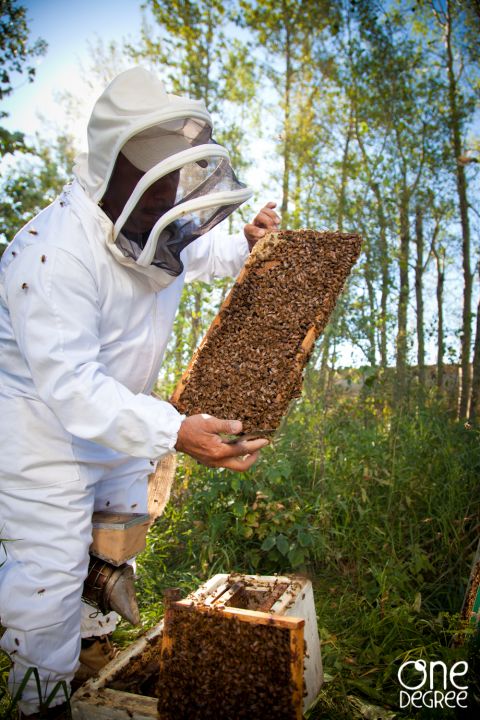Honey
Wolfe Honey Products
Organic farming is friendly to bees, and bees sure need more friends these days.
Few environmental changes are as heartbreaking as the collapse of bee colonies across the globe. Like the ruins of a veiled ancient civilization, hives once rich with golden treasure stand silent, crumbling onto the earth until only strips of hexagonal patterns remain — a code that was meant to be read, a warning soon to be lost.
As bees vanish, some of nature’s most majestic creations struggle to endure without pollination. What’s killing the bees is killing the beauty of spring.
By rejecting chemicals, organic farmers keep the environment healthy for bees and bee-lovers alike. And raising bees using organic principles does even more to keep them safe.
The organic raw honey that sweetens our Sprouted Oat Honey O’s cereal is from the Wolfe Honey Company in northern Alberta, Canada, where honeybees scout endless horizons of pristine clover fields, and have plenty of pesticide-free flowers and fruits to pollinate.
The story of these gentle bees and their world-famous raw light organic honey is a tale of purity, sustainability and ecological stewardship. Founder Gilbert Wolfe’s estimated half billion honeybees are never exposed to chemicals of any kind during the production process. The honey is raw, with no heat treatment, and pure, with nothing added to dilute or sweeten.
“When you heat honey, you destroy a lot of the goodness in honey,” Gilbert says. “The vitamins and enzymes are broken down and destroyed when heat is applied. Raw honey is extracted from a comb and placed in a container right away.”
As much as it is possible with such carefree creatures, Gilbert efficiently controls the whole process, from coronation of the queen to final packaging of the rare light nectar. When it’s time to remove honey from the hives, he uses a forced air technique, rather the chemicals that are widely used by other producers. By rotating equipment and taking extraordinary measures to keep the hives clean, he’s also able to avoid another industry standard: antibiotics. And when you know your product is the very best, there’s never any temptation to imitate some of the foreign suppliers who add syrup to their heated products.
“There’s a lot of honey out there that isn’t honey, imported from probably not the most reliable sources,” says Gilbert. “Packers, to lessen the cost, will blend honey and mix it in with sweeteners that aren’t honey.”
Gilbert got his first taste of the honey business at age 16 when his father, who farmed wheat, canola and barley here in the Peace River Valley, bought 50 beehives for him as a summer project. Twenty-five years later, Gilbert is still fascinated by bees. “When I see a bee out in the field, I really wonder how the bees will be foraging that day. I try to study the flight patterns each day; I really like to know where the bees are going and where they are coming from. What I like to do is just crouch down and watch the bees flying in and out of the hives, then you can determine what floral sources they are coming from.”
Watching the bees create beautifully symmetrical patterns in our camera lens, we too were enchanted by the sprightly striped explorers and their fragile monarchical societies. We knew that using the most bee-friendly honey we could find was an important step.
Like you, we believe nature cannot truly be in balance until bees return to where we know they belong — floating above blossoms in spring, buzzing inside cotton shirts in summer, busily knitting together the tapestry of life in gardens, orchards and fields.
— Charlie Dodge





